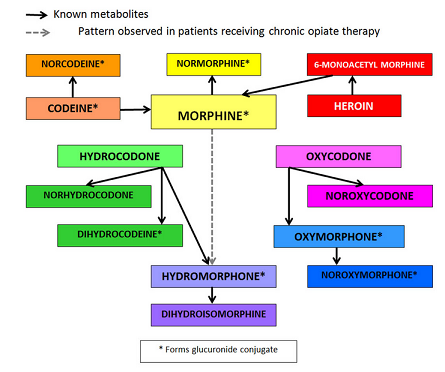Medical Pharmacology Chapter 13: Pain Management: Opioids
Opioid analgesics are generally well absorbed by cutaneous/intramuscular/mucosal surfaces
Transdermal fentanyl represents an important route of administration
Gastrointestinal absorption:
Some opioids are subject to first-pass metabolism.
Codeine and oxycodone exhibit both high oral and parenteral potency (protected from conjugation by substitution on C3 aromatic hydroxyl)
Various extent of plasma protein binding
Highest concentrations in tissues will be a function of perfusion
Skeletal muscle represents the largest reservoir
For highly lipophilic opioids (e.g. fentanyl), there is significant concentration in adipose tissue
Blood Brain Barrier:
Amphoteric agents (possessing both an acidic and basic group, e.g. morphine {phenolic hydroxyl at C3}: greatest difficulty for brain entry
Other substitutions that C3 improve blood-brain barrier penetration: e.g., heroin, codeine
Neonatal considerations: neonates lack the blood-brain barrier:
Placental opioid transfer (uses in obstetric analgesia) can result in depressed respiration in the newborn.
 |
|
Conversion to polar metabolites; renal excretion
Opioids with hydroxyl groups are likely conjugated with glucuronic acid
Examples:
Morphine
Levorphanol (Levo-dromoran)
Morphine-6-glucuronide: analgesic potency (perhaps > parent compound morphine)
In patients with compromised renal function, accumulation of metabolites occurs which prolongs analgesia
Esters-type opioids are: hydrolyzed by tissue esterases:
Examples:
Heroin
Remifentanil (short duration of action)
N-demethylation: minor pathway
Accumulation of demethylated meperidine (Demerol) metabolite, normeperidine:
Patients with decreased renal function or on high dosages: CNS excitatory effects:
Seizures (more likely in children)
Oxidative metabolism (hepatic) primary route of phenylpiperidine opioid metabolism:
Fentanyl (Sublimaze)
Alfentanil (Alfenta)
Sufentanil (Sufenta)
Polar metabolites are often excreted by the kidney (renal excretion) with small amounts excreted unchanged.
Glucuronide conjugates enter the bile and may be subject to enterohepatic circulation to a minor extent.
|
Way, W.L., Fields, H.L. and Way, E. L. Opioid Analgesics and Antagonists, in Basic and Clinical Pharmacology, (Katzung, B. G., ed) Appleton-Lange, 1998, pp 496-515. |
|
Coda, B.A. Opioids, In Clinical Anesthesia, 3rd Edition (Barash, P.G., Cullen, B.F. and Stoelting, R.K.,eds) Lippincott-Ravin Publishers, Philadelphia, New York, 1997, pp 329-358. |
|
Schuckit, M.A. and Segal D.S., Opioid Drug Abuse and Dependence, In Harrison's Principles of Internal Medicine 14th edition, (Isselbacher, K.J., Braunwald, E., Wilson, J.D., Martin, J.B., Fauci, A.S. and Kasper, D.L., eds) McGraw-Hill, Inc (Health Professions Division), 1998, pp 2508-2512. |
DISCLAIMER
|